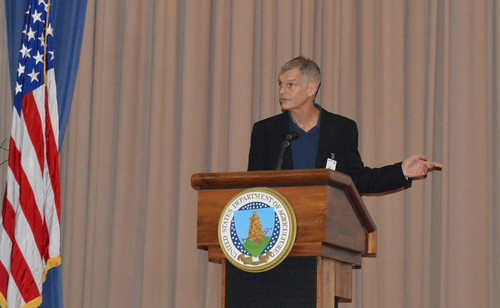
The number of people who had heart disease related surgeries, the percentage of Americans who take anti-depressants; the number of women who opt for natural childbirth, these are health statistics you likely hear about in the news frequently. But how do public health researchers obtain data about hard-to-reach, marginalized populations such as the homeless at-risk of contracting specific things like HIV/AIDS?
Producing statistics about hidden, underserved populations was one of the topics explored by Dr. Steve Thompson, professor of statistics at Simon Fraser University during the 25th annual Morris Hansen Lecture hosted by USDA’s National Agricultural Statistics Service (NASS). The lecture series was established by the Washington Statistical Society to honor Morris Hansen and his pioneering contributions to survey sampling and related statistical methods during his long and distinguished service at the U.S. Census Bureau. More than 200 people attended this year’s lecture at USDA’s Jefferson Auditorium in Washington.
Statistics are powerful tools in all disciplines, including public health, wherein researchers seek patterns of illnesses in groups. As a mathematical statistician, I’m proud to participate in education and outreach events, such as the Morris Hansen Lecture series, that invite the general public to learn more about the importance and usefulness of official government statistics.

Health statistics can help determine who is at risk for various diseases, find ways to prevent illnesses and decide which diseases should be further studied. As Thompson pointed out during his lecture, however, with hard-to-reach populations, traditional and standard survey methods don’t work too well.
These populations may include unauthorized aliens, informal sex workers, illicit drug users and people who live ‘off the grid’ – such as those who live off the land in the wilderness or in informal settlements and slums. According to Dr. Thompson there are instances where a researcher may want to collect data from hidden populations, but a sampling frame – a comprehensive list of all the members of the population the researcher wants to study – may not exist. In such cases using adaptive and network sampling techniques makes surveying hard-to-reach populations more feasible. Combining both statistical techniques often better captures information about hidden populations.
Thompson explained that adaptive and network sampling have interesting and useful applications in the fields of human health, environmental science, natural resources management, agriculture and much more. As government agencies, non-profits and private sector enterprises in the public health arena seek to improve the health of all their stakeholders, including those otherwise hidden or marginalized, adaptive and network sampling may help identify, explore and assist the most challenging groups.

